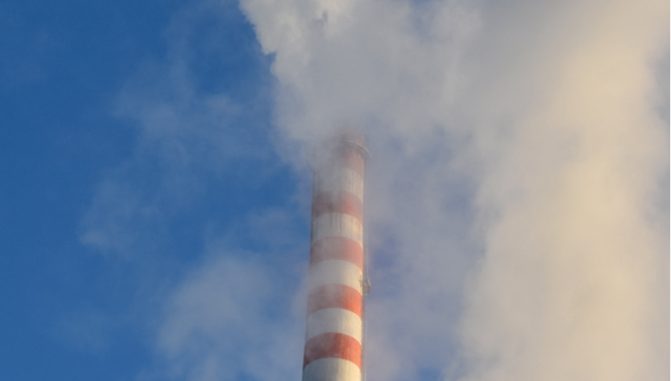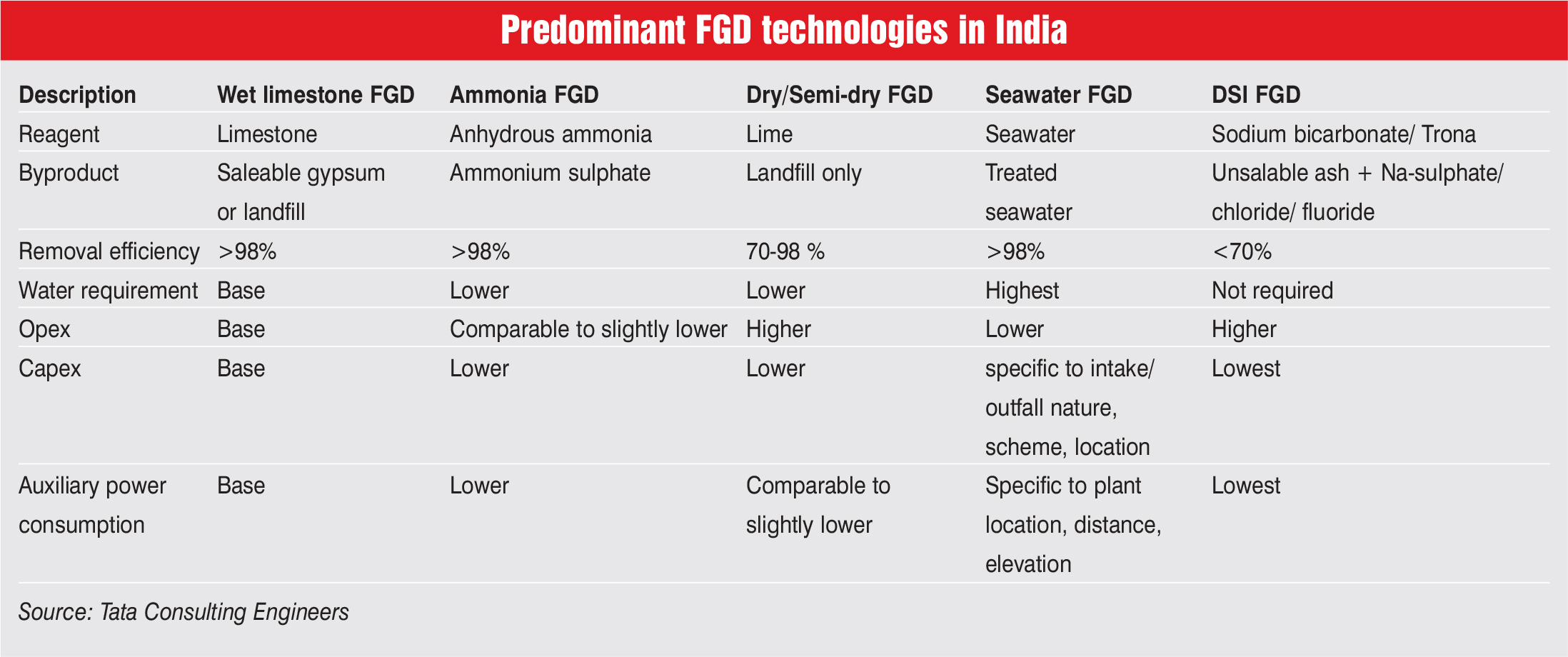
Flue gas desulphurisation (FGD) systems are a must have coal-based plants as they help comply with the stringent environmental norms notified by the Ministry of Environment, Forest and Climate Change (MoEFCC) on December 7, 2015. In order to reduce the sulphur dioxide (SO2) emissions, an FGD system is installed in the boiler of a TPP to absorb the sulphur content. One of the most widely used technologies for SOX control is wet FGD based on limestone. Apart from limestone, seawater and ammonia can be used in wet FGD as reagents. Some of the other post-combustion SOX control technologies are dry and semi-dry FGD, and dry absorbent injection (DSI).
SOX emissions can also be managed through pre-combustion technologies such as coal beneficiation, as well as in-combustion technologies such as circulating fluidised bed combustion (CFBC). The technology selection is based on several factors such as sulphur content in coal, SO2 removal efficiency requirement of a particular plant, availability of reagents (if any), disposal and handling of by-products, locational/geographical factors of the plant, unit size, plant life, and the space required for an FGD facility.
Wet FGD
The most commonly installed SOX re-moval technology solution is wet FGD. The first FGD system was installed at NTPC’s 500 MW Vindhyachal Stage V project in 2018 and was based on wet limestone technology. NTPC projects where wet FGD technology is being implemented include the 1,320 MW Solapur Super TPP, the 1,320 MW Tanda Stage II project, the 500 MW Unchahar project and the 1,320 MW Meja power project. In wet FGD processes, the flue gas is brought into contact with the sorbent in a separate absorber unit (wet scrubber). In a wet scrubber, a reagent such as a limestone or lime in a slurry form reacts in a spray tower with sulphur oxides to form calcium sulphite, which is oxidised to form calcium sulphate or gypsum. The wet limestone FGD has a removal efficiency greater than 98 per cent. A wet lime and magnesium enhanced lime process, or simply, the lime scrubbing process, typically contains calcium hydroxide slurry, which is more reactive but expensive than limestone. An extension of the wet lime process is the magnesium enhanced lime (MEL). MEL uses a mixture of limestone and magnesium hydroxide as the absorbent. The rate of absorption of SO2 is substantially higher than that of limestone slurry.
Seawater-based FGD system use seawater as a reagent. They require no other chemicals for SOX removal. Since seawater is naturally alkaline, it absorbs acidic gases such as SOX. The effluent seawater, after reaction, flows into a seawater treatment system to complete the oxidation of the absorbed SOX into sulphate. The sulphate ion thus formed is harmless and can be sent back to the sea. For a lower concentration of flue gas, one can achieve almost 99 per cent removal of SO2 through this process. For higher concentration levels, additional water is required. Applicable in the coal-fired power plants situated in coastal areas, the process is advantageous in terms of reagent and disposal waste. A seawater flue gas desulphurisation (FGD) plant is also being set up at Coastal Gujarat Power Limited’s 5×800 MW Mundra ultra mega power plant by Andritz India.
Dry/Semi-dry FGD
Semi-dry FGD processes, using hydrated lime as the reagent, have a low carbon footprint and have an apparent reagent cost. As compared to wet scrubbers, these systems consume about 60 per cent less water. The dry/semi-dry FGD technologies also have a removal efficiency of 70-98 per cent. In the case of semi-dry FGD, high purity lime is available in Rajasthan and Madhya Pradesh. The expected lime consumption for 22 GW is 2 mtpa and as the demand picks up, the production of the same shall rise, too.
DSI FGD
Another post-combustion SOX removal technology is DSI. It is preferable for small unit sizes in the 60-250 MW range. Since the cost of reagent in this technology is relatively higher than that in wet limestone and ammonia-based FGD, units running on low plant life factors and with low remaining operating lives (seven to nine years) are preferable for DSI. DSI has an SOX removal efficiency of 50-60 per cent. This is sufficient to meet the SO2 emission norms in cases where these emissions are in the range of 800-1,000 mg per Nm3. DSI uses calcium-based (calcium hydroxide) or sodium-based (sodium bicarbonate) sorbents to remove SO2. It is a feasible alternative for units that would not find it cost effective to invest in wet or dry FGD systems. Besides, the time needed to erect and commission a DSI system is only around one year, which is much lower than the time needed for other technologies. Additionally, DSI-based technologies have considerably low capex (one-fourth) and very little APC (one-tenth) compared to wet limestone – and ammonia-based FGD technologies. However, the downside of DSI is that sorbent injection generates extra dust loads on ESPs, thus necessitating simultaneous retrofitting of the ESPs. Notably, NTPC has opted for DSI at its Dadri power plant and Tanda TPS.

Other technologies
One of the in-combustion methods of managing SO2 emissions is the use of CFBC. In this method, crushed coal (5-20 mm in size) and limestone, mainly calcium carbonate (CaCO3), are injected into the bed, just above an air distribution grid located at the bottom of the bed. The boiler tubes are immersed in the fluidised bed and come into direct contact with the burning particles of coal. This results in a high rate of heat transfer. The limestone introduced with the pulverised coal reacts with the sulphur dioxide in the fluidised bed and absorbs it, thereby producing calcium sulphate or sulphite. The calcium salts thus formed are solid and remain trapped in the combustion chamber. SO2 emission reduction of up to 90 per cent can be achieved through fluidised bed combustion. Therefore, this method can even be used for high sulphur coal.
Another in-combustion SOX control technology is limestone injection. The limestone is either injected above the flame in the boiler, or into the duct work. The SOX present in flue gases bonds with the dry sorbent and forms sulphites, which can be captured in the existing particulate controls. It is mostly used for plants that do not have adequate land to install post-combustion control technologies. However, managing SOX emissions through boiler limestone injection requires sophisticated design and fabrication modifications to ensure that boiler efficiency is not affected.
Issues and challenges
There are various challenges in the implementation of FGD in the power sector. The availability of domestic FGD technology suppliers/vendors is limited and many leading EPC contractors/sub-vendors may reach a saturation point with parallel ongoing FGD projects. The number of bids awarded has been low, especially in the private and state sectors. The progress in the execution phase has been slow and decelerated further due to the Covid-induced pandemic. With difficulties in sanctioning and granting funds for FGD retrofits from various financial institutions, especially to existing power plants listed under NPAs/stressed assets, the industry has also faced fluctuations in terms of capex from unit/capacity-wise benchmarked values.
In the case of installation of wastewater treatment equipment with crystallisers/ZLD, clarity on auxiliary power limits is required, taking into consideration plant-specific variations in the auxiliary power limit from the Central Electricity Regulatory Commission benchmark values. For by-products, there is a need for the issuance of statutory guidelines and utilisation/disposal policies by the regulatory authorities. The distance/location measurement methodologies for plants, taking into consideration non-attainment cities, critically polluted areas, and cities with a population higher than one million also needs to be addressed.
Net, net, wet FGD based on limestone is the most popular technology solution for managing SOX emissions. However, various other emission control technologies are available in the market, and understanding their efficacy in the Indian context is critical. Besides, addressing issues pertaining to the availability of equipment, trained manpower and funding could facilitate compliance with the emission norms for TPPs.



